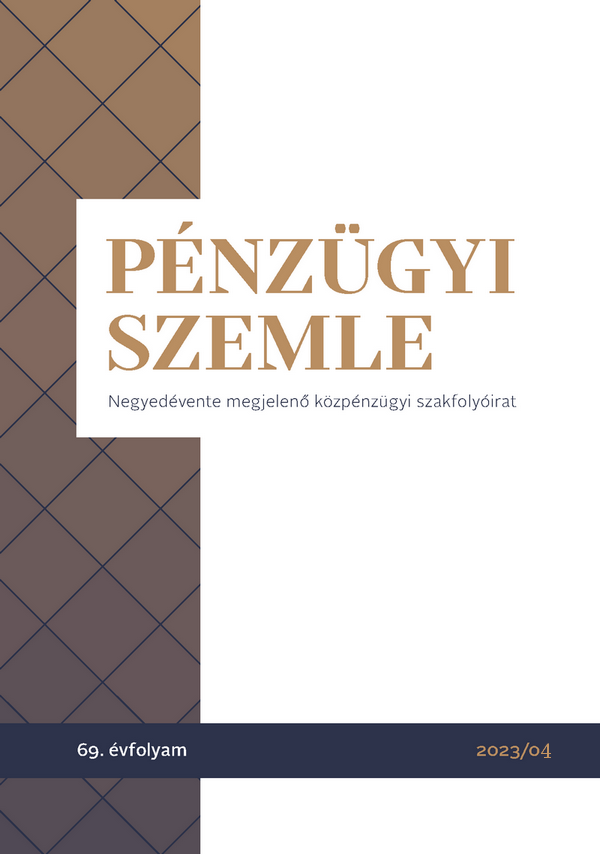The last 22 years of student lending – Analysis of the socio-economic impact of the student loan product family
DOI:
https://doi.org/10.35551/PFQ_2023_4_6Keywords:
student loans, higher education, return on investment, social mobility, C83, E61, E65, H52Abstract
The Student Loan Center was established 22 years ago by the first civic government with the aim of increasing access to higher education. The measure was particularly important in channeling talented students from poor financial circumstances into higher education. Over the past two decades, both higher education and the socio-economic environment surrounding higher education have changed considerably. The aim of this study is to examine the extent to which student loan instruments have been able to maintain their effectiveness over this period. Through a historical overview and the presentation of results from questionnaire data collection, the study demonstrates that student loan products have adapted to the changing environment by introducing and adapting existing products, and that they are still very popular among higher education students.
References
Állami számvevőszék (2008): Jelentés a Diákhitel Központ Zrt. működésének ellenőrzéséről. Budapest, 2008.
Berlinger, E., & Megyeri, K. (2015). Mélyszegénységből a felsőoktatásba. Közgazdasági Szemle, 62(6), 674-699.
Berlingieri, F., & Bolz, T. (2020). Earnings of university dropouts across Europe. ZEW-Centre for European Economic Research Discussion Paper, 20–085.
Chevalier, A., Harmon, C. P., Walker, I., & Zhu, Y. (2003). Does education raise productivity or just reflect it?.
Dear, K., Henderson, S., & Korten, A. (2002). Well-being in Australia: findings from the National Survey of Mental Health and Well-being. Social psychiatry and psychiatric epidemiology, 37, 503-509.
Duráczky, B. (2023). Predikciós-modellalkotás a hallgatói lemorzsolódás korai azonosítása érdekében a felsőoktatási intézményekben elérhető adatok alapján (Doctoral dissertation, Budapesti Corvinus Egyetem).
Ghignoni, E., Croce, G., & d’Ambrosio, A. (2019). University dropouts vs high school graduates in the school-to-work transition: Who is doing better? International Journal of Manpower.
Güell, M., Pellizzari, M., Pica, G., & Rodríguez Mora, J. V. (2018). Correlating social mobility and economic outcomes. The Economic Journal, 128(612), F353-F403.
Hajdu, G., Huszár, Á., & Kristóf, L. (2019). Mobilitás és társadalmi integráció. socio. hu, 42-61.
Hegedűs, R. (2016). Számok–arányok–mintázatok a felsőoktatásba felvett hátrányos helyzetűek esetében. Modern Geográfia, 11(3), 1-14.
Híves Tamás, Kozma Tamás (2014). Az expanzió vége. Educatio, 28(4), 659-682.
Kovács, E. (2017). A diákhitel kockázata. Köz-gazdaság-Review of Economic Theory and Policy, 12(2), 219-224.
Kovács, E. (2017). A diákhitel kockázata. Köz-gazdaság-Review of Economic Theory and Policy, 12(2), 219-224.
Luckman, M., & Harvey, A. (2019). The financial and educational outcomes of Bachelor degree non-completers. Journal of Higher Education Policy and Management, 41(1), 3–17.
Nyüsti, Sz. (2012). Jelentkezni vagy nem jelentkezni. A felsőfokú továbbtanulás során észlelt önkirekesztés és annak háttere. Felsőoktatási Műhely, 4, 85-100.
Pogácsás, C., Dióssy, K., & Vona, M. (2017). A magyar felsőoktatási felvételi szabályozása a felvételi számok tükrében a 2001-2015-ös időszakra vonatkozóan. Taylor, 9(1), 200-208.
Polónyi István (2014). A felsőoktatási továbbtanulás kistérségi összefüggései. Iskolakultúra, 24(5),3-17.
Polónyi István (2018). Felsőoktatási hallgatók bekerülési esélyei a hátrányos helyzetű kistérségekből. Statisztikai szemle, 96(10),1001-1019.
Polónyi, I. (2010). Hoztak is, meg nem is. Educatio, 19(1), 111-126.
Polónyi, I. (2012). Felsőoktatás és a gazdaság? Szép, új felsőoktatási világ Magyarországon. Iskolakultúra, 12(1), 50-56.
Róbert Péter (2000). Bővülő felsőoktatás: Ki jut be? Educatio, 9(1),79-94.
Schnepf, S. v. (2017). How do tertiary dropouts fare in the labour market? A comparison between EU countries. Higher Education Quarterly, 71(1), 75–96.
Szemerszki Mariann (2014). A középiskolából a felsőoktatásba. Jelentkezés és Felvételi tendenciák. Felsőoktatási Műhely, 1, 47-63.
Troia Media Kft. (2021): A diákhitel 20 éves működésének valószínűsíthető nemzetgazdasági hatásainak elemzése. Budapest, 2021
Downloads
Published
How to Cite
Issue
Section
License
Authors assign copyright to Pénzügyi Szemle / Public Finance Quarterly. Authors are responsible for permission to reproduce copyright material from other sources.












